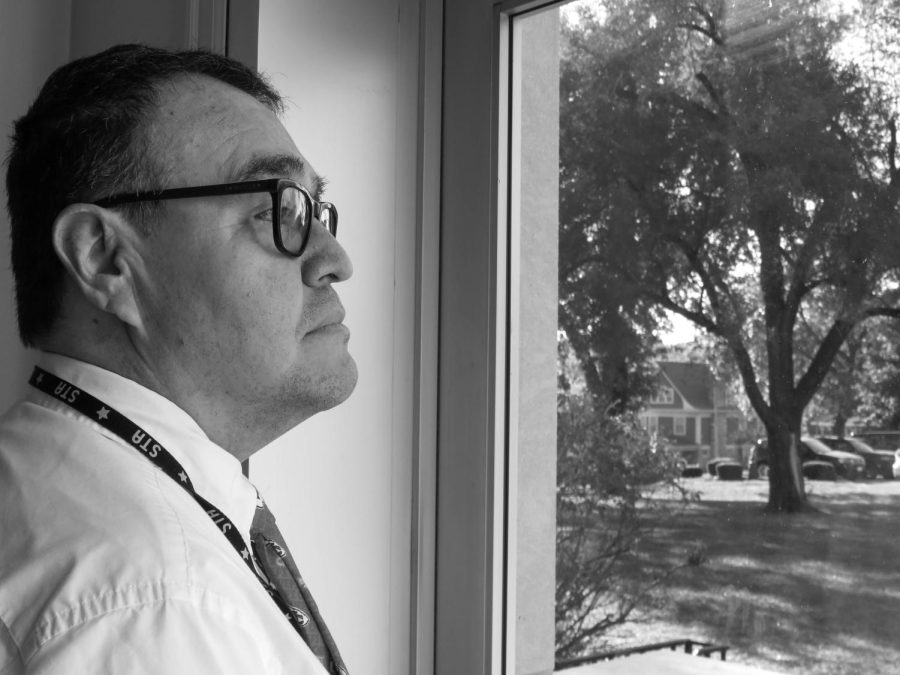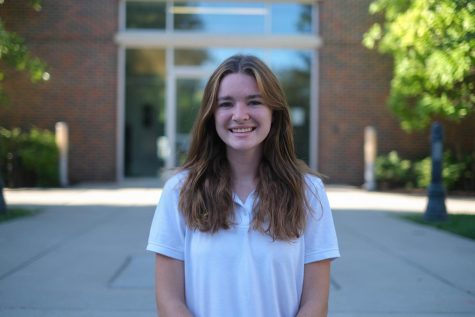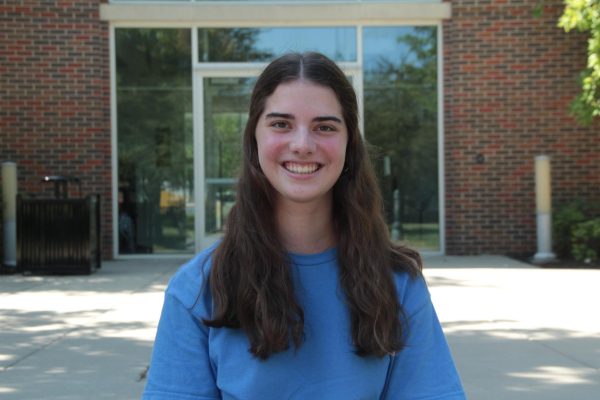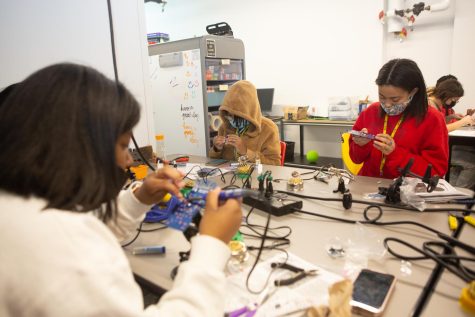How Does Gun Violence Affect The STA Community?
The recent increase in gun violence and school shootings has affected the STA community and spurred the implementation of new security measures to keep students and faculty safe.
October 24, 2022
So far in 2022, almost 30 school shootings have occurred in the United States alone according to The American Press. School shootings can happen anywhere and to anyone. Here in the Kansas City community, only a 30-minute drive from St. Teresa’s, there was an attempted school shooting at Olathe East high school in May 2022. But gun violence isn’t only confined to schools and it certainly isn’t a new phenomenon in our culture.
When he was 19, social studies teacher Nicolas Shump was working a late night shift at Wendy’s and stepped outside to get some fresh air. The next thing Shump knew, there was a man with panty hose covering his face pointing a gun at Shump. The gunman instructed Shump to turn around, put the gun in the small of Shump’s back and made Shump go to the restaurant’s office and give him all the money in the safe. After ripping all of the phones out of the wall, he made Shump count to 100, loudly, while he left. Shump then found a phone that had not been destroyed, called the police and spent the next three hours into the early morning being questioned.
“What was interesting was that this was 35 years ago, and he [the gunman] didn’t come in with semi-automatic weapons; he just had a handgun,” Shump said.
This generational difference of the accessibility of single-shot handguns to automatic and semi-automatic weapons is an important difference that Shump highlights. According to Forbes, of the 393 million guns owned by US civilians, there are more than 20 million semi or fully automatic weapons in circulation.
“We don’t need to have weapons that fire the kind of rapidity that weapons fire now; it’s unfortunate that that has become almost an absolute issue,” Shump said.
Shump believes that understanding the historical significance of guns and their purpose for personal and private use is helpful in understanding the political battle of gun rights.
“I teach government and it [the Constitution] says that you have the right to bear arms, but we know there’s a lot more to that,” Shump said. “Clearly, that was because we didn’t have a standing army and so we needed people to have weapons in case the British came back or whoever, but it’s not like that anymore.”
For Shump, being armed during the Wendy’s robbery would not have made him feel safer.
“I don’t think having a gun would have really helped me; it probably would have made it worse if I would have tried to be brave or something,” Shump said.
As a teacher, the recent rise in gun violence and school shootings worries him.
“What concerns me is some of the school shootings happened because students have been upset with grades, they’ve [the students] gone back and tried to kill the instructor,” Shump said. “Would I be less likely to be provocative in class? Because somebody might have a gun? I don’t know. There are times that I am sarcastic and I joke around and what if a student takes that wrong, pulls out a weapon? You don’t want to have to be thinking about that. I mean, I certainly don’t.”
Shump’s personal experience with gun violence as well as the rise in school shootings around the country have also worried him as a parent.
“I’ve gotten at least two or three emails this year, just [this] academic year for my daughter’s [school], Lawrence Freestate High School, saying there was an incident where there was a rumor a child is going to bring a gun to campus,” Shump said. “That scares me as a parent. [As a child] we didn’t have guns, we just didn’t. If we got into fights, maybe there would be a knife or mostly fists. The ease with which kids can get guns [today] is frightening.”
According to the Bureau of Alcohol, Tobacco, Firearms, and Explosives (AFT), the federal minimum age to purchase shotguns and rifles is 18, and at 21 individuals can purchase semi-automatic weapons. Shump maintains that as a society, we are not doing enough to combat gun violence.
“It’s nice that we’re talking about mental health, but we need to follow through, and even if we have better mental health, it doesn’t mean that we also can’t have more restrictions on guns,” Shump said.
Mike Foster, a member of the STA security team, also believes that mental health issues contribute to gun violence.
“If you dealt with that [the mental health crisis] more you’d get a handle on gun violence in this country,” Foster said. “People with mental illness should never have a weapon.”
Foster thinks that isolation during quarantine in the beginning of the COVID-19 pandemic was not helpful towards the issue.
“The amount of murders spiked during COVID.” Foster said. “How do you explain that? We were isolated. That’s probably to me the reason people do this is because they’re isolated. People need people. There’s a lot of mental illness out there.”
Shump believes that another key aspect of the fight against gun violence and school shootings is stricter gun access laws.
“[People say] ‘they’re taking our guns away,’” Shump said. “Really? Really? I don’t think they’re taking them away; they’re just saying maybe a background check. Maybe you should be a certain age. You have to drive so many hours or you have to take a test to get a driver’s license; you don’t just get one, but you can get a handgun pretty easily. People are so worried that any little thing that’s going to take away from that right would seem to make it to where we’re trying to take away their guns.”
Foster agrees that stricter gun laws would be helpful, but also admits that even with tighter restrictions, gun violence is always a possibility.
“You can get stricter gun laws but if a person wants to get a gun they’re gonna get a gun,” Foster said.
Due to this, STA has put many security measures in place to keep its students and faculty safe.
“We’ve had active shooter training, which was the drill that you [students] did, but we also do it for the teachers and they have a video they watch that the teachers have to do separately from what you had to do,” Foster said.
In addition to active shooter training, the security team also offers every teacher an evaluation of their classroom.
“What we do is we’ll go in, we’ll take pictures of their classroom and we will go over: where’s the exits, how to barricade, what to do in a certain situation, what to do when you have to fight, because it’s basically a fight, run, or hide, that’s the three things you have to do,” Foster said. “If the active shooter is in one building, what do you do? Where do you go if you run and things of that nature. Every teacher has an opportunity for me to go into their classroom. We also give them a safety bag and you see them probably hanging near their door. It’s got a hammer, it’s got spray and then a door stopper.”
The spike in school shootings over the past few years has resulted in increased funding for STA security, which are being used to add more cameras to campus to compensate for the many blind spots with the cameras that were installed before Foster was hired four years ago. In addition, campus security has also re-keyed every classroom so that each teacher has a key to their own classroom that does not work in the next classroom.
Future improvements include Visit You, a new form of checking into school with QR codes that could be active in less than a month.
Shump is appreciative of the safety measures implemented at STA.
“As much as it’s kind of a bummer to have to lock our doors and classrooms and have the badges and whatnot, we’re trying to do what we can as a school,” Shump said. “[Students who leave the classroom] to go to the restroom have to knock [to be readmitted to the class]; it’s sort of an inconvenience but you have to do what you can and it’s not going to unfortunately probably stop everything, but at least we can say we’re doing as much as we can.”
Foster believes that locking doors on campus will be essential in preventing harm to students and faculty if a school shooting incident were to arise.
“There has not been one incident where if there’s an active shooter on campus that he’s gone into a closed locked door,” Foster said. “They always go to rooms that are unlocked. If it’s a locked door, they are less likely to go in because they would have to waste time kicking the door in and trying to get the door to open. [The locking doors procedure] is just another barrier to keep them away from you guys.”
In the future, Shump might be more prepared to face gun violence due to his unique personal experience.
“Until you’re put in that situation, it’s tough,” Shump said. “The fact that I have had a gun pulled on me, that is something that many other people wouldn’t have had happen.”
Shump feels comfortable with the new procedures that have been implemented at STA and feels prepared if a dangerous situation were to occur.
“I try to be pretty level-headed; the most important thing is trying to keep everybody calm,” Shump said. “I’m good with the procedures and I feel this is a pretty safe classroom where it’s located.”
Shump also sees a bigger societal issue when it comes to gun violence.
“Shooters are mainly men; we don’t have a lot of female shooters,” Shump said. “Why is it that [it’s] boys? Why is it that [it’s] men? I’m glad that women aren’t going and shooting up buildings, but that’s another thing we’re not dealing with. We need to work on that and we need to say, ‘okay, there are ways for you to deal with your aggression without having to go and buy a gun and shoot up wherever.’”
STA’s unique position as an open, four building high school campus causes an added challenge to security.
“I can’t imagine what it’s like for Mr. Foster and Mr. Winn to have to secure everything; it’s not just one building,” Shump said.
Foster explains this security difficulty further.
“This campus is not ideal for security,” Foster said. “It’s perfect for the active shooter, but it’s not perfect for you guys. Some of the old classes are fine but this building [Goppert] is all glass. There’s just no protection behind glass; there is no hiding behind glass. A lot of times [in an active shooter situation] you absolutely have to run. And running to me is probably safest, as long as you’re not chaos running. Because you’re getting away from the person. It’s not like a guy with an AK 47 or something can run down the street for long distances.”
Ten years ago, at 2:30 in the morning, theology teacher Mimi Harman’s husband heard a knock at the door. Thinking it was one of Harman’s friends who needed help, he opened the door, only to see three masked men coming up to their porch. He shut the door and locked it. As the Harmans scrambled to find a phone, the men broke in and ordered them to stop.
Harman says the first thing that came to her mind was, “Jesus help us.”
The three intruders asked for money and Harman showed them to a jar in the kitchen with savings for their anniversary while her husband was put on the ground with a gun held to his head. After Harman gave one of the gunmen the jar, he pointed the gun at her and asked her to come with him, but she pushed the gun away and refused. The gunmen ran out the door and away with the money.
Although noting this experience was very traumatic for her husband and even her children, who were upstairs in their bedrooms at the time, for Harman it only strengthened her faith.
“In graduate school when I started studying about Jesus and I read the Gospels, I believed in his nonviolence and became an advocate against violence,” Harman said.
Although her conviction was strong, the first few days after the breakin were difficult.
“I was in shock for a while, and the next day this song came on with the Lord’s Prayer,” Harman said. “At the end of the Lord’s Prayer, it says ‘deliver us from evil for yours is the power and the kingdom now and forever’ and what evil does, it makes you afraid, and it takes away your power. Because I had studied nonviolence and I had learned about fear and I believed in Christ and in his nonviolence, I was able to keep that little sense of confidence where I did not abandon my power to those who had broken into our house. I was able to keep control and say those things that I did and so my opinion was strengthened in nonviolence.”
After the incident, Harman noticed guns everywhere.
“The next day I went to the grocery store and the security guard had a gun and I just had to stop and freeze because that has the power to take somebody’s life, and it often takes people’s power away, so I understand, especially from the news, that it can happen anywhere,” Harman said.
Foster also believes that our community needs to be more aware that gun violence really can happen anytime, anywhere.
“Next is just trying to take it [gun violence] more seriously, because it can happen; you never know,” Foster said.
According to Foster, an example needs to be set.
“It all starts with us, the older ones, the adults, the teachers, taking things seriously,” Foster said. If they [adults] take it serious you’ll [students] take it serious. So it really starts with teachers.”
Harman decided to use the break in as a learning experience instead of something that could hold her down and make her give in to violence.
“It strengthened my commitment and conviction of nonviolence because I feel like if we did have a gun it would have been worse,” Harman said.
Although she fully trusts the security staff at STA and believes that she is safe while at school, Harman also recognizes the importance of always being prepared for the worst to happen.
“I feel it’s very sad that schools have to do this, but I also think it’s important to teach that there are other alternatives to using violence to defend yourself,” Harman said.
Foster agrees that students and faculty should be able to feel safe while on STA’s campus, but what he worries about is when girls decide to leave.
“What we worry about is girls taking off on campus and just leaving,” Foster said. “You worry about it, you could go out and get robbed or something while you’re out and then we’re responsible for you when you’re supposed to be here. When girls try to leave for just lunch or something it’s really frustrating.”
Along with avoiding truancy, Foster emphasizes that it’s the simple things, like wearing access fobs and registering for STA parking permits, that unexpectedly go a long way.
“Girls lose things, you do, and you all have a lot on your plate, but just a little parking pass; it’s funny how easy it is to get it, it’s not that difficult and it helps me so much,” Foster said.
Harman finds that there are multiple nonviolent ways to confront a gunman.
“Trying to talk to them or say something that stops them in their tracks or flips the table,” Harman said.
Just like Shump and Foster, the most important thing to her is for everyone to realize that situations like this are real and do happen.
“I’m a realist; I know that stuff happens because it’s happened to me,” Harman said.
Harman relies on the power of love to fight gun violence.
“The power of love, God’s power, is more powerful than a gun, violence, anyone,” Harman said. “If you keep that, if you strengthen that, then you keep your own power and you don’t give it away in fear. I’m just seeing how guns in the inner city are so available and so out there and really have done nothing to make people safer. [It] just doesn’t seem like it’s the answer.”











